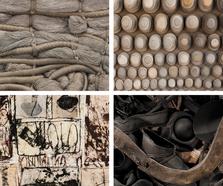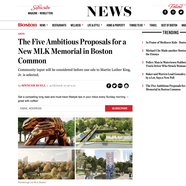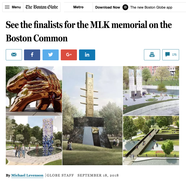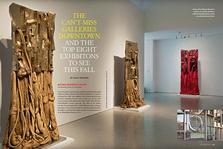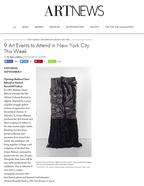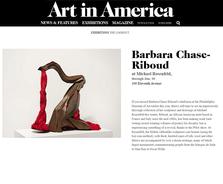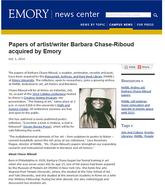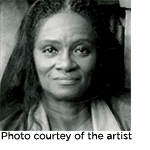
“I love silk, and it's one of the strongest materials in the world and lasts as long as the bronze. So it's not a weak material vs. a strong material so the transformation that happens in the steles is not between two unequal things but two equal things that interact and transform each other."
—Barbara Chase-Riboud
For over five decades, Barbara Chase-Riboud has created abstract art with a deep and nuanced understanding of history, identity, and a sense of place. Her celebrated work operates on several dichotomies that have become central to her practice: hard/soft, male/female, flat/three-dimensional, Western/non-Western, stable/fluid, figurative/abstract, powerful/delicate, brutal/beautiful, violence/harmony. In 1958, she developed her own particular innovation on the historical direct lost-wax method of casting bronze sculpture. Creating thin sheets of wax that she could bend, fold, meld, or sever, she developed singular models that she would then bring to a local foundry for casting. This new approach to a centuries-old process enabled her to produce large-scale sculptures comprised of ribbons of bronze and aluminum. In 1967, she added fiber to these metal elements, devising the seemingly paradoxical works for which she is most renowned — sculptures of cast metal resting on supports hidden by cascading skeins of silk or wool so that the fibers appear to support the metal. Of these works were a group of steles memorializing Malcolm X and his transformation “from a convict to a world leader.” His assassination in 1965, which upset the artist, was the impetus for the creation of her first works in the series, begun in 1969. Additions to the series came in 2003, 2007-08 and 2016-17, totaling twenty sculptures. Known collectively as the Malcolm X Steles, the first thirteen sculptures were exhibited in 2014 to acclaim at the Philadelphia Museum of Art and the Berkeley Art Museum (University of California Berkeley). In 2017, Michael Rosenfeld Gallery presented Barbara Chase-Riboud—Malcolm X: Complete, the artist’s second large-scale solo exhibition at the gallery which celebrated the completion of the series and represented the first time that fourteen of the twenty steles were shown together. The exhibition was accompanied by a fully illustrated color catalogue featuring a recent interview with the artist by Carlos Basualdo, the Keith L. and Katherine Sachs Curator of Contemporary Art at the Philadelphia Museum of Art.
Born in 1934 in Philadelphia, Barbara Chase-Riboud began taking art classes at the Philadelphia Art Museum and the Samuel S. Fleisher Art Memorial at an early age. Wrongly accused of plagiarizing a poem she had written, Autumn Leaves, her mother had her removed from middle school and tutored at home before enrolling her in the Philadelphia High School for Girls in 1948. Four years later, Chase-Riboud graduated from high school and began studying at Temple University’s Tyler School of Art. Following an exhibition of her prints at the ACA Gallery in New York in 1954, The Museum of Modern Art purchased her woodcut Reba in 1955. The following year, she graduated from Temple with a BFA, won a Mademoiselle guest-editorship award and moved to New York to take a job with Charm magazine. In 1957, on the recommendation of noted art director Leo Lionni, she won a John Hay Whitney Fellowship to study at the American Academy in Rome. While in Rome, in 1958, she had her first European exhibitions at the American Academy and at Galleria L’Obelisco and her work was included in the first annual Festival of the Two Worlds in Spoleto. At this time, she also traveled to Egypt, an experience which would profoundly influence her mature work. She returned to the United States in September of 1958 with a fellowship to pursue her MFA at Yale University School of Design and Architecture where she studied with Josef Albers, Phillip Johnson, Paul Rand, and Alvin Eisenman. Soon after, her sculpture Bull-Fighter was included in the 1958 Pittsburgh International Exhibition of Contemporary Painting and Sculpture at the Carnegie Mellon Institute. At Yale, Chase-Riboud encountered the British architect Sir James Stirling, a visiting critic, who proposed to her shortly afterwards. In 1960, the twenty-one-year-old artist completed her first commissioned public work, the Wheaton Plaza Fountain in Maryland (whereabouts unknown), and received her MFA from Yale, the first African American woman to do so. Chase-Riboud did not attend commencement; she moved instead to London to rejoin Stirling.
Later that year, Chase-Riboud left London to settle in France. In Paris, she was hired as an art director by the New York Times International and began a successful sculpting career, establishing her studio in 1962 on rue Blomet. Subsequent studios included those on rue Dutot and rue des Plantes in Paris, as well as the one at her country home, La Chenillère, in the Loire Valley, where she neighbored with Alexander Calder. In Paris, she met and befriended Alberto Giacometti, Salvador Dalí, Max Ernst, Dorothea Tanning, Georges Mathieu, Man Ray, Roland Penrose and Lee Miller, among other notable cultural figures. She also met Henri Cartier-Bresson and his protégé, legendary photojournalist Marc Eugène Riboud, whom she later married. In 1965, Chase-Riboud traveled to the People’s Republic of China, with Riboud, as the first American woman invited to visit the country since its political revolution. The following year, she received a sculpture commission from fashion designer Pierre Cardin and represented the United States in the first World Festival of Negro Arts held in Dakar, Senegal. Later that same year, she also had her first major gallery show, held at the Galerie Cadran Solaire in Paris. In 1969, the exhibition 7 Américains de Paris opened at the Galerie Air France in New York, where Chase-Riboud exhibited five new sculptures including Sheila, which, significantly, was her first work to combine cast metal and fiber. She also traveled to Algiers, Algeria for the first Pan-African Cultural Festival. In 1970, four works from the Malcolm X series were shown at the Bertha Schaefer Gallery in New York and later that year, at the Hayden Gallery at the Massachusetts Institute of Technology in Cambridge, MA. At this time, the Betty Parsons Gallery in New York began representing the artist. In 1970, she participated in the exhibition Contemporary American Sculpture at the Whitney Museum of American Art, becoming, alongside Betye Saar, the first African American woman to exhibit at the museum. In 1973, the exhibition Chase-Riboud, organized by Peter Selz, was shown at the University Art Museum in Berkeley, CA, traveling to the Detroit Institute of Arts and the Indianapolis Museum of Art. In 1974, she held solo exhibitions at the Musée d’Art Moderne de la Ville de Paris and at the Kunstmuseum Düsseldorf and Staatliche Kunsthalle Baden-Baden in Germany. In 1975, following an exhibition at Betty Parsons Gallery, she departed on a month-long lecture and solo exhibition tour of Africa, organized by the U.S. State Department, with venues in Tunisia, Mali, Sierra Leone, Ghana and Senegal. In 1977, she was included in the prestigious Documenta VI in Kassel, Germany and two years later, she participated in the 3rd Biennale of Sydney: European Dialogue in Sydney, Australia. In 1980, Chase-Riboud divorced Marc Riboud and the following year, she married Italian art publisher Sergio Tosi, a collaborator of Man Ray, Marcel Duchamp, Lucio Fontana, Cy Twombly, Jean Tinguely, Niki de Saint Phalle and other prominent artists.








